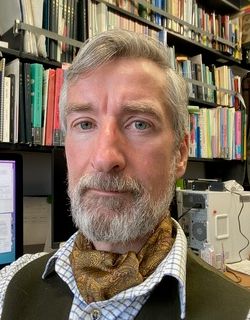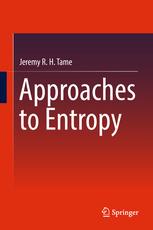Jeremy Tame


My group focuses on biophysical studies of how proteins fold and function.
The principal techniques used are protein crystallography,
analytical ultracentrifugation and isothermal titration calorimetry.
We have a well-equipped laboratory for manipulation of DNA, protein
expression and crystallisation,
and we have published extensively in both general science
journals and more specialist biochemistry publications.
My publication list is available from Google Scholar
here.
My ORCID page can be seen
here.
My book Approaches to Entropy is available from Springer
here.
After I graduated from Cambridge University in England, I moved down
the road to the MRC Laboratory of Molecular Biology. Following a short
period of funding arranged by the Nobel prize winner Max Perutz, I became a regular student in
the group of
Kiyoshi Nagai,
who was working on methods to create
site-directed mutants of human haemoglobin, a protein that proved
highly difficult to express in bacteria at that time.
My PhD thesis involved the first mutational studies of the
alpha subunit of human
haemoglobin, showing its behaviour is very different from the
beta subunit, and I still have enormous interest in haemoglobin
as a test-bed for protein structure-function studies, as well
as a wonderful opportunity to observe evolution on the molecular
level. My group refined the crystal structure of haemoglobin to
atomic resolution, in both the oxy and deoxy states, greatly
clarifying the nature of the interactions between the protein and
the diatomic ligand. This work has been widely cited by groups
working in diverse fields from allostery to molecular dynamics simulations.
We have also studied a variety of animal haemoglobins showing that
evolution has created very different mechanisms for regulating the
oxygen affinity of the protein. Many fish, for example, use
Hb to drive oxygen into the swim-bladder against a strong concentration
gradient. We have shown that very different residues at different
positions on the protein may be used to create extremely pH-sensitive
oxygen affinity effects.
Crocodiles have a unique mechanism of exploiting bicarbonate ions to
drive oxygen off their haemoglobin, and my PhD thesis helped establish
the site of bicarbonate binding. My group has recently solved the structure
of crocodilian
haemoglobin by cryo-electron microscopy, showing exactly how this works.
The paper describing this work is open access, and available
here.
A follow-up paper submitted to BioRxiv can be found
here.
In the future, I would like to develop human haemoglobin
with the crocodilian bicarbonate binding site engineered into it,
which may prove to be helpful for many patients with limited lung function.
Protein design
Recently my group has collaborated with Prof. Arnout Voet at KU Leuven
to produce novel proteins with perfect Cn symmetry. The first of
these designs, called Pizza, was a beta-propeller protein with six-fold
symmetry. This protein showed that a single polypeptide chain with
a number of domains of identical sequence can still fold properly, contrary
to some ideas that such a protein would suffer "folding frustration"
as the domains interfered with each other, leading to a misfolded aggregate.
We have used Pizza to create a miniature crystal of cadmium
chloride with only 19 atoms, and we are now building on this work
to make templates to form metallic nano-clusters with uses in a variety
of fields including medicine and biotechnology. The basic design model, of
a propeller protein with six blades of identical sequence, can be
found at PDB here:
3WW9.
The paper describing the protein and its design can be found via Pubmed
here.
Anti-cancer lectins
My group has solved the structure of a novel lectin called MytiLec, isolated
from the edible mussel, Mytillus galloprovincialis. This protein
has a beta-trefoil structure, and a novel form of sugar-binding site.
This protein targets particular types of cancerous cell that express
globotriose on the cell surface. By binding to galactose residues,
Mytilec recognises these cells, and by unknown means enters them
and kills them. The high-resolution structures solved by our group
showed that the interactions between the protein and ligand are unlike
those of previously solved lectin structures.
The crystal structure can be downloaded from the PDB at
3WMV.
The paper describing the protein and its sugar binding can be found via Pubmed
here.
Thermodynamics of protein-ligand binding
I have a long-standing interest in protein thermodynamics, starting with
haemoglobin, but also including sugars, peptides and small molecule drugs.
I have been invited to speak at a variety of meetings on this topic, and
my work on the peptide-binding protein OppA has proved very popular as
a system to test ideas on relating protein structures and ligand binding energies.
My work on OppA in the 1990s was the first attempt to relate a number of crystal structures
of a protein bound to several different ligands, and the ligand affinity
measured by calorimetry.
A freely available paper describing the crystallographic and thermodynamic analyis
of several OppA complexes can be found via Pubmed
here.
Two commentaries of mine on the calculation of ligand affinity from static
protein crystallographic models have been highly cited, the first, published
in 1999, pointed out that many algorithms were highly simplistic and unlikely
to work reliably and generally. The second shows that there is no thermodynamic
basis for believing that separate entropic and enthalpic terms can be calculated
even approximately from static, desolvated models. The two papers can be
downloaded
here
and
here.
Japan, science and other writing
2025 is the centenary year of the isolation of methionine by Satoru Ohdake.
A small article titled "100 Years of Methionine" celebrating his work,
and discussing the naming of amino acids
generally, is available to download
here.
Python programs
A small collection of Python programs
can be found here.
The programs include LSQFIT, which can overlay structures using any ATOM records
in model files, and
CONTACT, which produces lists of close atom pairs in a form that can be used directly in manuscripts.
If you would like to contact me or my group, please find the
relevant information on the
Contact page.
Latest Updates
September, 2019:
We were devastated to learn of the sad death of Kiyoshi Nagai, who has passed
away from liver cancer in Cambridge. You can learn a little more about this
truly wonderful man
here.
April, 2021:
I served as Editor for Biophysical Reviews, and was requested to
provide a short autobiographical piece, which is free to download
here.
November, 2023:
I was delighted to be invited to speak at a memorial meeting, to be
held at the MRC LMB in Cambridge, commemorating
the life and work of Kiyoshi Nagai and Chris Oubridge.
March, 2025:
My debut television appearance, wearing a crocodile hat!
April, 2025:
It was a pleasure to welcome Beatrice Vallone of La Sapienza University, Rome, to visit us.
July, 2025:
From July I will be starting a sabbatical involving stays at Warwick University
in the UK, and La Sapienza University in Italy. I am grateful to both for their generous support!